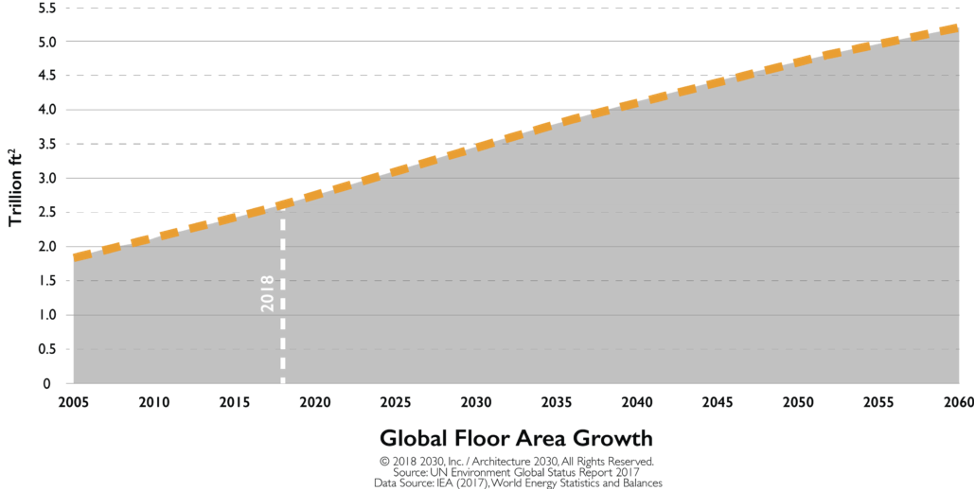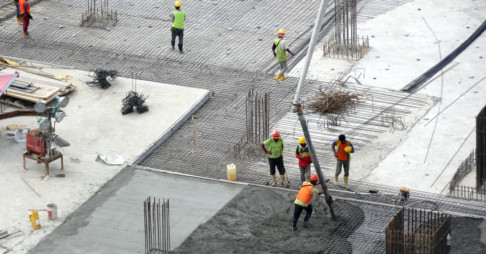By Christie Gamble
Just before the COVID-19 pandemic affected public events across North America, 400 leaders from the design and construction community came together in Los Angeles to address a different global threat: embodied carbon.
CarbonPositive’20 Conference and EXPO, hosted by Architecture 2030 and ARCHITECT Magazine, convened March 2-4. The event was centered around the topic of embodied carbon in the built environment. Embodied carbon is the carbon footprint of buildings and infrastructure that occurs prior to the beginning of the building’s operations. It’s the carbon footprint that comes from the manufacturing of the building materials, transportation of these materials, and construction practices.
Concrete’s Role in Embodied Carbon Reduction
As the most abundant manmade material on the planet — and therefore the largest contributor to embodied carbon — concrete was a central topic at the event. However, thanks to the efforts of the National Ready Mixed Concrete Association’s (NRMCA) Build with Strength initiative, concrete was mainly discussed as a potential solution to the growing problem of embodied carbon.
Ed Mazria, founder of Architecture 2030 and renowned global climate influencer, kicked off the conference with a keynote address that hammered home the urgency to achieve significant embodied carbon reductions in North America within a short timeframe. According to Mazria, to stay within the global carbon budget defined by the Paris Agreement, the embodied carbon of buildings and infrastructure needs to decline by 65% by 2030 and be eliminated by 2040.
The considerable challenge to achieving reductions of this scale is magnified by the growth in construction expected to occur over the coming decades. The world’s building stock is expected to double by the year 2060. This is equivalent to building another New York City every month for the next 40 years!

The majority of North American developments is expected to occur within the next decade, alongside development in European and Asian countries. Following that surge of construction in the Global North, a considerable amount of construction growth is expected to occur within the Global South throughout the latter half of the next 40 years. This leads to two important considerations:
- Any progress in construction practices made across the Global North over the next two decades will considerably influence construction practices in the Global South.
- Most North American construction is happening in the near term, which means that the building materials to complete those projects are being manufactured in the even nearer term. Once the CO₂ is emitted from an industrial process, it cannot be recovered.
There is good news, however. Between 2005 and 2019, the United States saw an unprecedented decoupling of GDP and CO₂ emissions from the building sector. GDP rose at a rate considerably higher than the rate of carbon emitted from the construction and operations of buildings . This is a strong indication that initiatives to reduce carbon emissions do not pose a threat to economic growth.
Equally promising, Lionel Lemay of the NRMCA proudly reported in his keynote that the ready mixed concrete industry measured a 13% decline in the carbon footprint of concrete since 2014. He said, “When you consider that most construction projects don’t have sustainability goals, 13% is pretty good. We [the concrete industry] made this reduction on our own initiative.”

When Architecture 2030 issued the Challenge for Products in 2011, the NRMCA was one of the first industries to support the challenge. Lemay stated that the industry would continue to respond to the growing demand voiced by architects, engineers, contractors, owners, and policymakers to reduce the carbon footprint of building products. But he emphasized in his address that the industry could not face this challenge alone; it needs the design and construction community to implement those demands in practice.
“We, concrete manufacturers, need your help,” Lemay said to the CarbonPositive’20 audience. “We need you to specify innovations. We need you to remove barriers in your specifications that prevent us from doing our part to reduce our environmental impact. We need you to incorporate embodied carbon reduction goals in your designs and specifications. We’re committed to reaching those carbon reduction targets that you’ve set out for us, but we need you to support our efforts along the way.”

Christie Gamble (center) alongside Sara Neff, Senior Vice President, Sustainability, Kilroy Realties (left), and Kate Diamond, Principal, HDR Inc. (right).
Collaborative Efforts to Solve Global Problems
Amidst the COVID-19 crisis and the stories of isolation, supply chain shortages, and economic uncertainties, stories of hope and collaboration have emerged. Despite physical separation, reports continue to materialize of individuals coming together to protect the most vulnerable. People who are grocery shopping for their elderly neighbors, food banks that have adapted operations in order to continue to safely supply food to the hungry, young and healthy individuals who choose to stay at home in order to protect the elderly and the immunodeficient, free childcare being offered to the health care workers who are on the front lines — exhausted, yet resilient.
The endless examples of collaboration throughout the COVID-19 crisis shows that humans are capable of collaborating across industries and organizations to tackle any problem that poses a threat to our way of life. The overwhelming tone of the CarbonPositive’20 conference was one of hope and optimism against a formidable challenge. Mazria, for his part, made no attempt to sugarcoat the severity and complexity of the global carbon problem, but he also laid out a vision that led the room to believe that this challenge is not insurmountable.
Similarly, Lemay’s comments echoed Mazria. Significantly reducing concrete’s carbon footprint over the coming decades will not be easy. It will require cement and concrete manufacturers to make substantial changes to the ways in which they operate, while continuing to serve the demands of their customers and support their employees and communities. But with deliberate collaboration between owners, architects, engineers, contractors, policymakers, manufacturers, industry associations, and innovators, the path forward is visible.
It’s up to each of us to follow it.
About the Author
As Senior Director of Sustainability for CarbonCure Technologies, Christie Gamble drives CarbonCure's mission to reduce 500 megatonnes of annual carbon emissions from the concrete industry. The CarbonCure Technology, which is installed in over 200 concrete plants across North America and Singapore, enables concrete producers to utilize post-industrial carbon dioxide to achieve significant embodied carbon reductions without compromising concrete quality. In her role, Gamble collaborates closely with designers and builders who seek to reduce the carbon impact of building and infrastructure projects. Gamble is also a member of the Board of Directors of the Carbon Leadership Forum.

How SBTi’s New Standards Could Unlock Corporate Climate Potential

